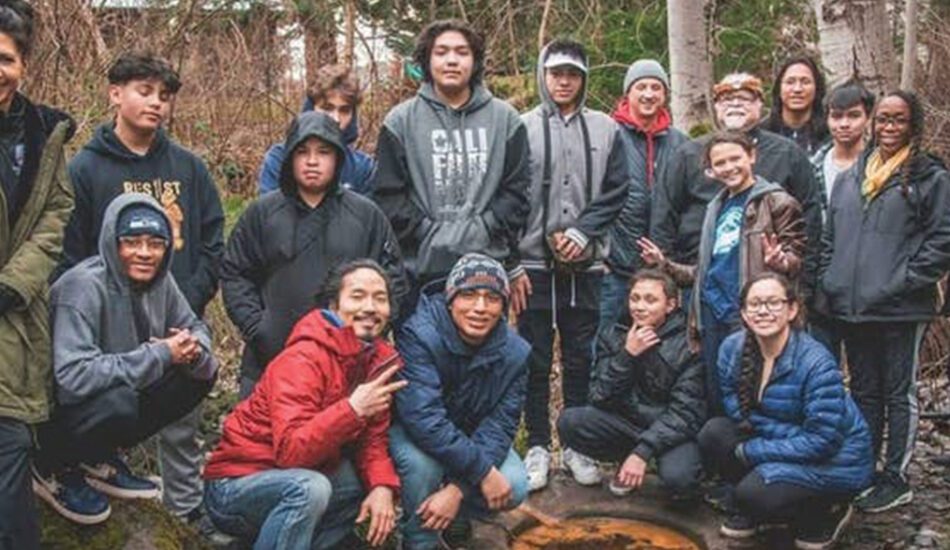By FRANK HOPPER, courtesy of Indian Country Today and Author Frank Hopper (Tlingit, Kagwaantaan)
For thousands of years, a vast network of mineral springs, in what is now North Seattle, was known by its Lushootseed name, le?qtid, pronounced “LEE’kteed.” Its waters were sacred to all the tribes in the area. The local Duwamish built sweat lodges there and performed ceremonies using its red clay to adorn their bodies. Le?qtid means “Red Paint” or “Red Pigment.”
But most of the springs are now paved over, covered by asphalt and concrete. Residential houses and a shopping mall now dominate the area that was once filled with many healing springs. Only one remains.
Situated in a small park, Licton (after the Lushootseed “le?qtid”) Springs sits right in the middle of what is considered prime Seattle real estate. It’s just a few blocks north of the Woodland Park Zoo and a few blocks southwest of the Northgate Shopping Mall. The spring sat precariously on the edge of potential urban development for years until a young Lakota activist saw a chance to save it, and to teach a new generation of Native youth in the process.
Saving a sacred spring
“It’s the last remaining one,” Seattlebased Lakota activist Matt Remle told Indian Country Today. “A couple of years ago, I was talking to some Duwamish folks and I asked, ‘Do you guys have any sort of cultural, historic preservation on this?’ They said, ‘No, we don’t. Could you help us look into all that?’”
Because there wasn’t any sort of official preservation status on the area, Remle began researching how to obtain landmark and historic preservation status for the spring. But as he began working on obtaining historic protection status for Licton Springs, he stopped and thought he should involve Native youth in the process. He needed to pass the baton.
“I was thinking we’ve got to do a better job reaching out, especially to our younger folks, by teaching them how to do these things. We’re not going to be around forever. Somebody’s got to know these ropes, so I reached out to Sarah Sense-Wilson, with her youth group, Clear Sky.”
Enter the Seattle Clear Sky Native Youth Council
The Seattle Clear Sky Native Youth Council began in 2009 as a response to the lack of cultural, social and academic support for urban Native youth. As part of the Urban Native Education Alliance, the Council provides a number of activities and programs to teach Native youth leadership and academic skills as well as culturally relevant training in community and civic service.
Sarah Sense-Wilson, chair of the Urban Native Education Alliance, leads the Clear Sky group. They meet weekly at the Robert Eagle Staff Middle School, which is right in the neighborhood of Licton Springs. Last year, Remle approached Sense-Wilson, explaining he thought Clear Sky was the perfect group to help save the spring.
Starting last summer, the group learned about the site’s history directly from local Native Elders of the Duwamish, Snoqualmie and other tribes. Duwamish Elders Ken Workman and Thomas Speer spoke to the group and showed them around the site and held ceremonies there with them. Snoqualmie Chief Andy De los Angeles taught them about the importance of having reverence for the outdoors. Sense-Wilson led the group in brainstorming sessions to come up with ways to protect the site.
At one workshop, the group created a petition to designate Licton Springs as a historic site, which they planned to submit to the City of Seattle. The petition is written from a Native perspective, emphasizing the cultural and spiritual importance of the springs, something the young people learned directly from Elders.
As they listened to the teachings and interacted with Native leaders, they came up with the idea of making a documentary about the site and their efforts to protect it. That’s when the magic started happening.
Their efforts attract others
Choctaw/Seminole filmmaker and cofounder of Longhouse Media, Tracy Rector and her associate Che Sehyun, along with C. Davida Ingram and Orlando Lugo of the Seattle Public Library, offered to help them create the documentary.
The first filmed interviews with Elders were recorded in January. The group plans to launch a social media campaign centered around the documentary to inform the community about the importance of the site. They hope to restore its original vegetation and even revitalize other springs in the area. Their petition to the City of Seattle currently has nearly 800 signatures.
Native teamwork, a blow against colonization
When the wisdom of the past meets the youthful energy of the future, a blow is struck against the relentless onslaught of colonization. The importance of this partnership between past and future generations is made clear by Duwamish Elder and historian Thomas Speer:
“Le?qtid cannot be re-created, replaced or relocated. Its importance is beyond measure and description, and its value is beyond price. The Duwamish People are the stewards of le?qtid, other holy places, and the natural endowment that dókwibuA (Creator) bestowed upon our ?ál?altid (Ancestral Homeland).”
Photo: Native youth and Elders urge historic protection status for Seattle’s Licton Springs, where healing waters once flowed. Photo courtesy of Indian Country Today.





